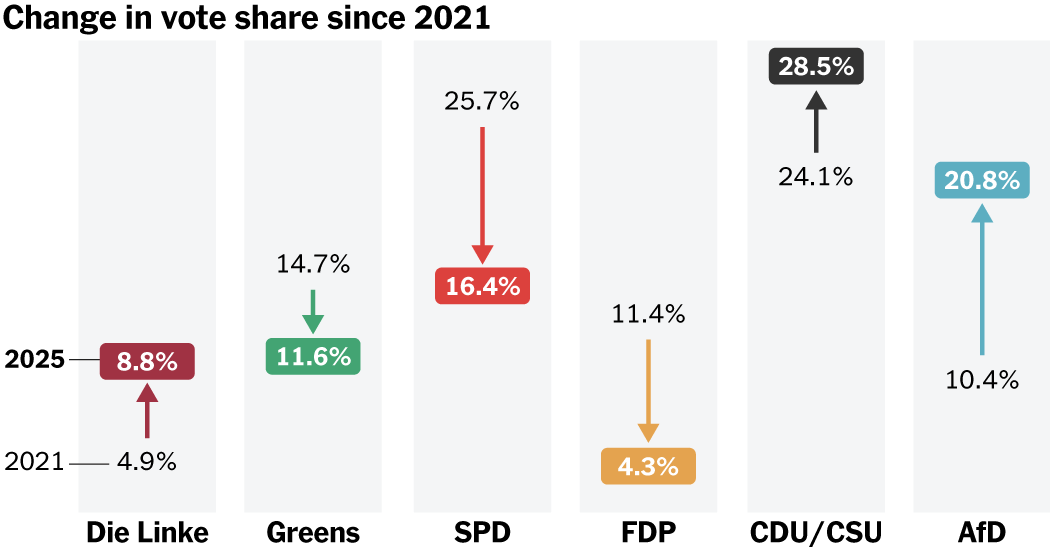Table of Contents
How the 630 seats will be distributed
Germany’s conservative
Provisional results by party
| Party | Votes | Pct. | Seats | |
|---|---|---|---|---|
| CDU/CSU | 14,158,432 | 28.52 | 208 | |
| AfD | 10,327,148 | 20.80 | 152 | |
| SPD | 8,148,284 | 16.41 | 120 | |
| Greens | 5,761,476 | 11.61 | 85 | |
| Die Linke | 4,355,382 | 8.77 | 64 | |
| Others | 2,273,817 | 4.58 | 1 | |
| BSW | 2,468,670 | 4.97 | 0 | |
| FDP | 2,148,878 | 4.33 | 0 |
Voters gave the far-right
Change in vote share since 2021
The Christian Democrats, AfD and Die Linke won more votes than in the last general election.
There were smaller surprises, including the last-minute surge of the far-left party
Highlighting the widespread discontent with Mr. Scholz’s government over the last three years, all three parties in the coalition — the Social Democrats, the Greens and FDP — lost support.
Vote shifts since 2021
Germans cast two votes when they go to the polls. The first vote goes to elect a direct representative for their district, while the second vote is cast for a party.
Arrows show the increase or decrease in each party’s vote share in the second vote, compared with the last general election.
Christian Democrats
Center right
Alternative for Germany
Far right
Social Democrats
Center left
Free Democratic Party
Liberal
Support for the Social Democrats plunged everywhere, but nowhere more than in the east. The Christian Democrats made gains throughout the southern and western districts.
The coalitions
The Christian Democrats will need to build a coalition to govern because they did not win an outright majority of seats. Given Sunday’s results, the most likely pairing is the CDU and the incumbent Social Democrats.
That combination would return the country to the more durable two-party form of government that has led it for most of this century, most recently during Angela Merkel’s final term as chancellor.
Possible mainstream coalitions
CDU/CSU and SPD 328 total seats
CDU/CSU and Greens 293 total seats
CDU/CSU, SPD and Greens 413 total seats
Unlikely coalitions
CDU/CSU and AfD 360 total seats
316 seats needed
for majority
The largest possible coalition, the one between the Christian Democrats and the second-place finisher, the AfD, is politically not an option. The CDU’s leader, Friedrich Merz, has promised never to join with the AfD, which routinely flirts with Nazi slogans and whose members have diminished the Holocaust and have been linked to plots to overthrow the government.
But the returns showed that the AfD is a growing force in German politics.
Support surges for the AfD
The far-right AfD doubled its vote share from four years ago and came first in most constituencies in the former East Germany, which has long been its base. The party also won the most votes in two constituencies in the west for the first time.
Where the AfD has won the most votes
The AfD came in first in most constituencies in the former East Germany.
Won the most votes in 7 constituencies.
Won the most votes in 17 constituencies.
Won the most votes in 49 constituencies.
Note: Map shows the results of the second vote in each election.
Thirty-five years after the reunification of East and West Germany, the country is still divided, and so are its voters. The prosperity gap between the two is one reason so many people — especially young people — have left the East.
Sources: Regionaldatenbank Deutschland and Bundesagentur für Arbeit.
Note: Age data is as of December 31, 2023, the unemployment rate is from November 2024, and the disposable income per capita is from 2021.
The constituencies where the far-right AfD won the most votes mapped closely to the boundaries of the former East Germany, with some exceptions around Berlin and Leipzig, where the far-left Die Linke party was most popular.


